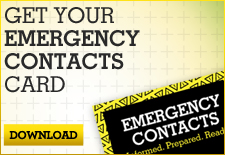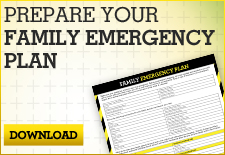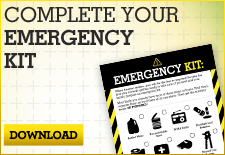
Disasters can happen… at any time. Be prepared to take action before, during and after.
A radiological attack is the spreading of radioactive material with the intent to do harm. Radioactive materials are used every day in laboratories, medical centers, food irradiation plants, and for industrial uses. If stolen or otherwise acquired, many of these materials could be used in a Radiological Dispersal Device (RDD).
The health effects of radiation tend to be directly proportional to radiation dose. If a reasonable estimate can be made of a person’s dose, a lot is known about the health effects at that dose.
Detailed information on your local television and radio stations, your local government’s emergency management website, Federal government websites like the Federal Bureau of Investigation and their social media outlets like Twitter and Facebook.
Before
Prepare for a radiological attack by knowing the best method to protect yourself and your family during an attack is to use time, distance, and shielding. Following any radiological explosion, you should:
- Minimize the time you are exposed to the radiation materials from the dirty bomb.
- Maximize your distance from the source; walking even a short distance from the scene could provide significant protection since dose rate drops dramatically with distance from the source.
- Shield yourself from external exposure and inhalation of radioactive material.
2 – Complete the Emergency Contacts Card and place one in your Emergency Kit.
3 – Prepare an Emergency Kit. The Emergency Kit should be easily accessible should you and your family be forced to shelter in place (stay at home) for a period of time.
- Blast shelters are specifically constructed to offer some protection against blast pressure, initial radiation, heat, and fire. But even a blast shelter cannot withstand a direct hit from a nuclear explosion.
- Fallout shelters do not need to be specially constructed for protecting against fallout. They can be any protected space, provided that the walls and roof are thick and dense enough to absorb the radiation given off by fallout particles.
Find out from officials if any public buildings in your community have been designated as fallout shelters. If none have been designated, make your own list of potential shelters near your home, workplace, and school. These places would include basements or the windowless center area of middle floors in high‐rise buildings, as well as subways and tunnels.
If you live in an apartment building or high‐rise, talk to the manager about the safest place in the building for sheltering and about plans to provide for building occupants until it is safe to go out.
If you are outside when a radiological attack occurs, cover your nose and mouth and get into a nearby building. It is important to minimize the time you are exposed but increase the distance and to shield yourself from potential exposure.
- If you are inside, check your building for damage and find better shelter if necessary.
- Close windows and doors and turn off all heating, cooling and ventilation systems.
- Stay put and stay informed through TV or local radio.
- Shield yourself with a thick piece of material between you and any radioactive materials.
- Stay away from any obvious plume or dust cloud.
- Cover your mouth and nose with a tissue, filter, or damp cloth to avoid inhaling or ingesting the radioactive material.
- Walk inside a building with closed doors and windows as quickly as can be done in an orderly manner and listen for information from emergency responders and authorities.
- Remove contaminated clothes as soon as possible; place them in a sealed container such as a plastic bag. The clothing could be used later to estimate your exposure.
- Gently wash skin to remove possible contamination; make sure that no radioactive material enters the mouth or is transferred to areas of the face where it could be easily moved to the mouth and ingested. For example, don’t eat, drink, or smoke before removing the contamination.
After a radiological incident, remember that if you are exposed you can expose or contaminate other people with whom they come in close contact. Avoid contact with others until you (or they) are decontaminated. Seek medical attention after officials indicate it is safe to leave your location, especially if you have inhaled or ingested radioactive material. Do not return or visit the incident location for any reason until local officials have declared that it is safe.
- Establish a plan for careful monitoring and assessment of affected areas.
- Impose quarantines as necessary to prevent further exposures.
- Remove contamination from areas where persons might continue to be exposed.



